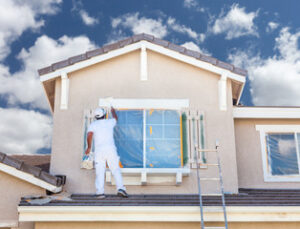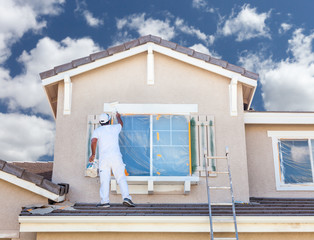Painting your bathroom is a satisfying and relatively easy home improvement project. You just need to take a few extra steps to ensure a smooth and successful outcome.
Moisture is the enemy of paint, especially in bathrooms. Steam from showers and water splashes from sinks or tubs can cause mold to form, which can damage and stain your paint. Read https://bunburypaintingservice.com.au/ to learn more.

If you want a bathroom that looks fresh and clean, the right paint is essential. Since this space is constantly exposed to moisture, it’s important to choose a mildew-resistant formula. You should also opt for a washable paint, as this will be easier to keep clean and free of mold. If possible, look for a paint that has antimicrobial additives to further reduce the risk of mould growth.
Choosing the correct paint style is also key. In years gone by, it was common for interior painters to use semi-gloss paint in bathrooms, as this type of finish was considered more moisture resistant and could be cleaned more easily than flat/matte or eggshell paint. Nowadays, there are many different types of paint with various sheen levels that will perform well in a bathroom, so you can decide what is best for your space.
In addition to choosing the right paint, it’s essential to ensure your bathroom is properly prepped before starting your painting project. Thorough cleaning and priming of walls will seal porous surfaces and create a smooth surface for your primer and paint. You should also make sure your bathroom is well-ventilated to keep condensation and fungus at bay. Finally, don’t skip the step of putting up an exhaust fan – this is one of the most effective ways to minimize the likelihood of mildew and other spores growing on your bathroom walls.
A good primer will not only help your new paint adhere to the surface, but it can also hide any evidence of water damage, cover cooking, smoking or candle stains and even conceal minor wall flaking. Make sure to follow the manufacturer’s directions and allow the primer to dry completely before beginning your actual paint job.
The rest of the supplies you’ll need for this task are fairly simple: a roller, tray, angled paintbrush, painters tape, sandpaper, a flat-head screwdriver to remove electrical plates, a tarp for the floor and your chosen paint. If you’re unsure about what color to choose, ask your local paint store for recommendations or pick up samples from a home improvement store to see how the colors look in the space at different times of day.
A bathroom is a wet room, and moisture is one of the biggest issues when painting these rooms. If the paint isn’t designed to handle the moisture then it will start peeling and chipping over time, and this is especially true for wall color. So it is important that you choose a paint with mildew-resistant properties to help protect the surface of your walls.
It is also important to prepare the walls before you start painting, as this will ensure that the new paint adheres properly and looks great. So start by washing the walls using a sponge dipped in a solution of one part bleach to three parts water. Make sure the room is well-ventilated while you are cleaning and be sure to scrub any existing mildew spots. After washing, allow the walls to dry completely before you begin painting.
Next, lightly scuff the walls with a fine grit sandpaper to dull any existing paint and to ensure that any new coat of paint will stick to the surface. If you do this before priming then it will save you a lot of time and work later on. Finally, be sure to remove anything that you can from the walls (like draperies and pictures), and cover up any surfaces that you can’t get rid of (like outlets and switch plates). Masking these areas will prevent you from accidentally rolling paint on them when you are finished.
When you are ready to paint, be sure that you have all of your tools and supplies nearby so that you can quickly get started. It is a good idea to put down a tarp or drop cloth in the room to protect any items that you can’t move, and to use painters tape to mask off any areas that you will not be painting, like doors, windows, and base trim.
Be sure to use a stain-blocking primer before painting in the bathroom, as this will help to ensure that your new paint won’t bleed into any existing marker or crayon marks. Marker and crayon marks can bleed through even several coats of regular primer and paint, so it is important to wash them off before applying any new coatings. If the marks still bleed through, you may need to apply some spackling or joint compound and re-tape the corner bead before re-priming and repainting.
Paint is one of the easiest and most cost-effective ways to give a room a new look. It is also a great way to add some color and flair to a space, as well as send a message to potential buyers that the home was lovingly cared for and maintained. When it comes to bathroom painting, choosing the right paint is a crucial step to ensure lasting quality and prevent water damage. There are many different paint and coatings on the market, and each has its own benefits and drawbacks. Most pros recommend using a semi-gloss or high-gloss finish, which is designed to be easy to clean and resist mold and mildew.
Before you begin, make sure to prepare the space by cleaning it thoroughly. This will help the new paint adhere properly, and it will also ensure that any existing mildew is removed before it can bleed through the new coat. It is best to use a sponge dipped in a solution of water and bleach, and it is important to make sure that the room is well-ventilated while you are cleaning (open a window or turn on the exhaust fan).
Once the walls are cleaned, you are ready to begin the actual paint job. Start by cutting in with a brush around the edges of the wall, and then switch to a roller for the rest. Be sure to stir the paint before pouring it into a tray or dipping your brush in, as this will help to evenly distribute the pigments.
If you are painting over a light color, consider using a primer to help the color go on smoothly and to help reduce any mildew issues that may arise. You can find a variety of primers available from most home improvement stores, and it is usually recommended to apply a coat of primer before you begin the painting process.
Once the first coat is dry, evaluate whether you will need a second coat. Depending on the color and the condition of the previous paint, you may only need a single coat. However, if you are going from a dark to a light color, or vice versa, it is typically recommended to do two coats.
A fresh coat of paint on the walls can do wonders to brighten a room, and while painting a bedroom or living room is a fairly familiar task for most do-it-yourselfers, painting a bathroom requires special care. Due to the constant exposure to moisture and mildew, it’s essential to take all the necessary steps to protect your new paint job.
First, make sure to thoroughly clean the walls before you start painting. Remove any loose wallpaper and patch any holes or cracks. After that, cover anything you can’t remove with a drop cloth or sheet, and then start prepping the surfaces for painting. If you’re going to paint over existing wallpaper, make sure to use a wallpaper paste that is water-resistant. You’ll also want to remove any fixtures, like light fixtures and mirrors, from the walls.
Once you’ve prepped the space and painted, you’ll want to add a finishing touch. Consider adding a layer of clear or semi-gloss wax to your paint to help seal the surface and make it easier to wipe down. This will keep your bathroom looking great for longer, and it’s a perfect solution for high-moisture areas.
It’s also important to choose a waterproof paint. Raleigh house painters can recommend products that are made to resist mold, mildew and other moisture issues. This type of paint typically costs more than standard interior paint, but it can save you money and headaches in the long run.
